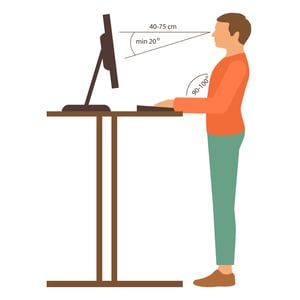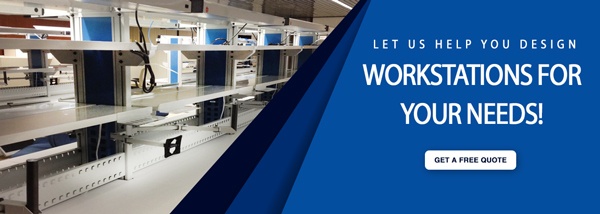While many businesses focus on the functionality of industrial furniture, the truth is that industrial furniture design has evolved to include several innovative features that are on the leading edge of design.
Products are now designed to not only foster efficiency, but also meet the needs of various employees and situations while still looking stylish and holding up to intense conditions.
These top trends in industrial furniture design are taking the manufacturing and laboratory industries by storm.
Modular Furniture And Evolving Workspaces
The COVID-19 pandemic showed the critical need for adaptability in the workplace. As companies evolve to meet the dynamic demands of the modern world, modular furniture systems play a key role in this evolution, offering flexible and interchangeable solutions that allow businesses to quickly respond to changing needs and optimize their work environments.
dynamic demands of the modern world, modular furniture systems play a key role in this evolution, offering flexible and interchangeable solutions that allow businesses to quickly respond to changing needs and optimize their work environments.
In industrial, manufacturing and laboratory settings, furniture often needs to be reconfigured to accommodate various tasks and workflows. Modular furniture systems provide the flexibility to easily rearrange workstations, shelves and storage units. This adaptability helps optimize the workspace for different projects and team needs, promoting efficiency and productivity.
Modular laboratory furniture is designed with interchangeable components that can be quickly swapped out or upgraded. This feature allows for easy customization and adjustments as requirements change over time. Whether it's adding new storage solutions, upgrading to more advanced technology integration, or simply replacing worn-out parts, modular systems ensure that the furniture remains functional and up-to-date without the need for complete replacements.
A Greater Focus On Productivity
Industrial furniture design that enhances productivity is important for modern work environments. Current trends focus on technology integration and add-on accessories to streamline tasks and improve the overall employee experience.
Here are some of the methods industrial furniture manufacturers are incorporating into the designs of their products to help boost productivity:
Technology Integration
- Built-in integrated electrical, data, and mechanical systems like air, gas or plumbing to reduce setup time and enhance efficiency
- Dedicated spaces for specific types of monitors or testing equipment to facilitate smooth operations
Add-on Accessories
- Plug-and-play capabilities that allow technicians to easily connect test monitors, laptops or mobile devices for presentations and diagnostics
Industrial Automation
- Automation integration of technologies, ensuring seamless integration with robotic systems, automated tools, and smart devices.
By focusing on these trends, companies can create more efficient, adaptable and productive industrial work environments.
Flexibility Is Here To Stay
Flexibility is a trend in industrial furniture design that is not going away anytime soon for two reasons.
Employees want to be able to choose how to use their industrial furniture and equipment based on the type of work they are doing. For example, for collaboration or innovation there might be open workbenches or casual seating that can facilitate group work and conversation. When concentration is needed or individual work, there might be private work areas or secluded workbenches.
Industrial furniture should be able to scale based on the needs of the worker or workgroup. For example, if an employee over 6 feet tall wants to use the same workbench as an employee under 5 feet tall, the workbench must be flexible enough to accommodate these varying heights.
Furniture that can be easily moved, adjusted or expanded allows companies to adapt to changing workflows and project demands. By embracing flexibility, companies can create a versatile and adaptive workplace that meets the diverse needs of their employees and supports various work styles and tasks.
Ergonomic Tools For A Safer Workspace
Improper and repetitive movements often lead to injury. Think about slouching, reaching for a sample or even sitting for long periods of time. This is why ergonomics have become such an important part of industrial furniture design. More managers are embracing ergonomics to protect employees from painful muscles and joint conditions.
long periods of time. This is why ergonomics have become such an important part of industrial furniture design. More managers are embracing ergonomics to protect employees from painful muscles and joint conditions.
Adjustable height workbenches allow people to either sit or stand when working, which is key to meeting the needs of employees of varying heights.
Ergonomic chairs or stools that allow the user to adjust things like arm position, height, seat depth and even back lumbar support helps each employee – regardless of size – to find the correct posture and position for their body type.
Monitor arms allow for easy movement of one, or multiple computer monitors in order to keep them at the correct eye level for different employees.
Keyboard trays can help keep employees’ shoulders and wrists in the correct position when a height adjustable desk is not an option or when an employee is working in a shared space.
Add-on accessories to modular workstations are available to improve posture and prevent injury from reaching too far or in the wrong position. These accessories include bins, shelves, lighting, document holders and headsets.
Durability And Sustainability Are Top Priorities
In industrial furniture design, durability and sustainability are paramount. The use of durable materials like stainless steel, phenolic resin, and epoxy resin ensures that furniture can withstand the rigors of demanding work environments. These materials are chosen for their strength, longevity and resistance to wear and tear.
There also is a growing emphasis on eco-friendly options, with sustainable materials and environmentally-friendly manufacturing processes becoming increasingly important. Depending on your workplace environment, you may be able to explore materials like sustainable wood or recycled materials.
By prioritizing both durability and sustainability, industrial furniture not only meets the practical needs of the workplace but also aligns with broader goals of environmental responsibility and resource conservation.
Not All Industrial Furniture Is The Same
Though it may seem like common sense to incorporate productivity, flexibility and ergonomic enhancements into all industrial furniture designs, not all industrial products are created equal.
It's crucial to recognize that simply having an industrial style or design does not guarantee that furniture can withstand the demanding conditions of your specific work environment. The appearance of ruggedness does not always equate to actual durability and functionality.
Research and evaluate. Before committing to a purchase, conduct thorough research. Look into the materials used, the manufacturing process and the reputation of the manufacturer. Assess whether the furniture can endure the specific wear and tear it will encounter in your facility, including exposure to chemicals, heavy loads or continuous use.
Focus on industry trends. Keeping an eye on industry trends can help you stay informed about the latest advancements in industrial furniture design. Trends like technology integration, eco-friendly materials and modularity are continually evolving. Staying updated can help you make informed decisions that align with current best practices and innovations.
Test and validate. Whenever possible, test the furniture in real-world conditions before making a large investment. This validation process can ensure that the furniture meets your durability and functionality requirements. Look for reviews and case studies from other businesses with similar needs to see how the furniture has performed in their environments.
Consider customization. In many cases, off-the-shelf solutions may not meet all your needs. Consider working with manufacturers who offer customization options to tailor the furniture to your specific requirements. Custom solutions can provide the exact features and resilience needed for your particular operations. Our article, How To Customize An Industrial Workbench With Storage, offers some ideas on how to get the most out of your purchase.
Look at your purchase as a long-term investment. View industrial furniture as a long-term investment rather than a short-term purchase. High-quality, durable furniture might come with a higher initial cost but can save money over time by reducing the need for frequent replacements and repairs. Well-designed ergonomic furniture can also enhance worker comfort and productivity, leading to long-term benefits for your business.
By thoroughly evaluating your options and considering the unique demands of your work environment, you can ensure that the industrial furniture you select will not only look the part but also perform reliably under challenging conditions.


